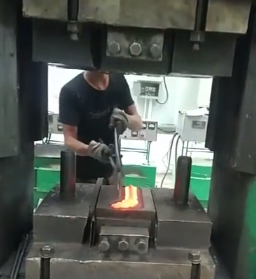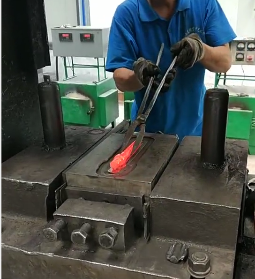When forging titanium alloy, due to improper process specifications, raw material quality control is not strict, forging may have a variety of defects.
Defects of titanium alloy forging and their prevention are as follows:
1.β brittleness: β brittleness is caused by the forging overheating, α and (α + β) titanium alloys, especially (α + β) titanium alloys, if the forging heating temperature is too high, beyond its β transition temperature, resulting in the forging of low-fold microstructure grain large, isometric shape.In order to prevent overheating, when titanium alloy is heated, the furnace temperature should be strictly controlled, the temperature of qualified zone in the furnace should be measured regularly, and the charging level and amount should not be too large.
2.Local coarse crystal: during die forging with the pressure hammer or forging press, due to the poor thermal conductivity of titanium alloy, the temperature of the surface layer of billet in contact with the mold decreased a lot, so that the structure of raw materials remained, and new local coarse crystal was formed.In order to avoid the partial coarse crystal defect of titanium alloy, the following measures can be taken: adopt the preforging sequence to make the deformation even during the forging;Strengthen lubrication, improve the friction between billet and die;Preheat the die sufficiently to reduce the temperature drop of billet during forging.
3.Crack: the surface crack of titanium alloy forging is mainly produced when the final forging temperature is lower than the full recrystallization temperature of titanium alloy. In order to control the occurrence of cracks, glass lubricant can be used when forging on the forging press, or when forging on the forging hammer, the contact time between the blank and the lower die can be shortened as far as possible.
4,Residual cast structure: when forging titanium alloy ingots, if the forging ratio is not large enough or the forging method is not appropriate, the forging will leave a residual cast structure. The solution to this defect is to increase the forging ratio and to use repeated upsetting.
5.Bright strip: the so-called bright strip in titanium alloy forging is a strip in the low-power tissue with unusual brightness visible to the naked eye. There are mainly two reasons for the bright strip: one is the chemical composition segregation of titanium alloy, the other is the deformation thermal effect in the forging process.
6.αembrittlement layer: theαembrittlement layer is mainly the titanium alloy at high temperature oxygen and nitrogen through the loose oxide skin, the inner diffusion of the metal, the surface metal oxygen and nitrogen content increased, so that the number ofαphase in the surface tissue increased. In order to avoid this embrittlement layer too thick, the forging or heat treatment of the heating temperature, holding time and furnace gas properties, must be properly controlled.
7.Hydrogen brittleness:Hydrogen brittleness has two types:strain time type and hydride type.The problem of hydrogen brittleness is caused by the content of hydrogen in titanium alloy exceeds the standard.Thus,the content of hydrogen in industrial titanium alloy must be controlled within 0.015%.For prevent and reduce hydrogen brittleness,


when forging or heat treatment on the forging press, the furnace should be slightly oxidized. For hydrogen content exceeding the regulation and important titanium alloy parts, vacuum annealing can be carried out to eliminate hydrogen embrittlement.